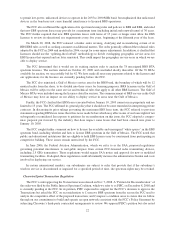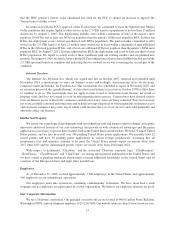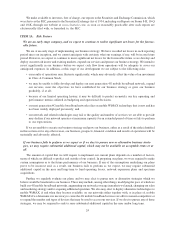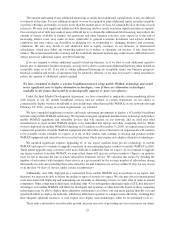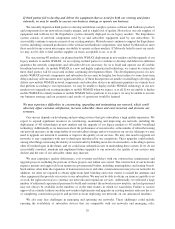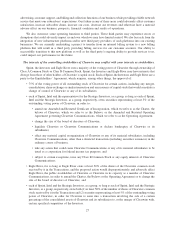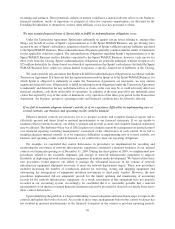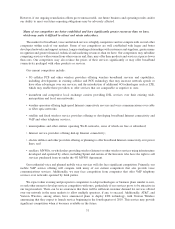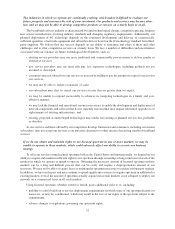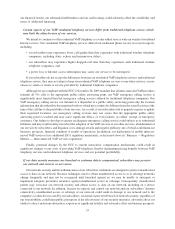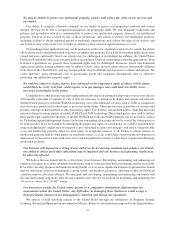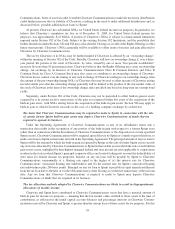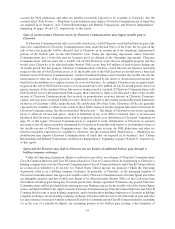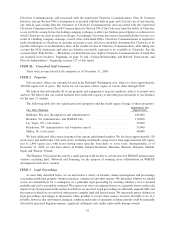Clearwire 2009 Annual Report Download - page 42
Download and view the complete annual report
Please find page 42 of the 2009 Clearwire annual report below. You can navigate through the pages in the report by either clicking on the pages listed below, or by using the keyword search tool below to find specific information within the annual report.Th
ein
d
ustries in w
h
ic
h
we o
p
erate are continua
lly
evo
l
ving, w
h
ic
h
ma
k
es it
d
i
ff
icu
l
t to eva
l
uate ou
r
future prospects and increases the risk of your investment. Our products and services may become obso
-
l
ete, an
d
we ma
y
not
b
ea
bl
eto
d
eve
l
o
p
com
p
etitive
p
ro
d
ucts or services on a time
ly b
asis or at a
ll.
T
he broadband services industr
y
is characterized b
y
rapid technolo
g
ical chan
g
e, competitive pricin
g
, frequent
n
ew service introductions, evolving industry standards and changing regulatory requirements. Additionally, ou
r
pl
anne
dd
ep
l
o
y
ment o
f
4G tec
h
no
l
o
gy d
epen
d
sont
h
e cont
i
nue
dd
eve
l
opment an
dd
e
li
ver
y
o
f
commerc
i
a
lly
s
u
ffi
c
i
ent quant
i
t
i
es o
f
networ
k
equ
i
pment an
d
su
b
scr
ib
er
d
ev
i
ces
b
ase
d
on t
h
e 4G tec
h
no
l
o
gy
stan
d
ar
df
rom t
hi
r
d
-
p
arty suppliers. We believe that our success depends on our ability to anticipate and adapt to these and othe
r
ch
a
ll
en
g
es an
d
to o
ff
er compet
i
t
i
ve serv
i
ces on a t
i
me
ly b
as
i
s. We
f
ace a num
b
er o
f diffi
cu
l
t
i
es an
d
uncerta
i
nt
i
e
s
assoc
i
ate
d
w
i
t
h
our re
li
ance on
f
uture tec
h
no
l
o
gi
ca
ld
eve
l
opment, suc
h
as
:
•ex
i
st
i
ng serv
i
ce prov
id
ers may use more tra
di
t
i
ona
l
an
d
commerc
i
a
ll
y proven means to
d
e
li
ver s
i
m
il
ar o
r
alternative services;
• new serv
i
ce prov
id
ers may use more e
ffi
c
i
ent,
l
ess expens
i
ve tec
h
no
l
og
i
es,
i
nc
l
u
di
ng pro
d
ucts not ye
t
i
nvented or develo
p
ed;
• consumers ma
y
not su
b
scr
ib
e to our serv
i
ces or ma
y
not
b
ew
illi
n
g
to pa
y
t
h
e amount we expect to rece
i
ve
f
o
r
our serv
i
ces;
• we may not
b
ea
bl
e to rea
li
ze econom
i
es o
f
sca
l
e
;
• our su
b
scr
ib
ers may e
l
ect to cance
l
our serv
i
ces at rates t
h
at are greater t
h
an we expect
;
•wema
y
be unable to respond successfull
y
to advances in competin
g
technolo
g
ies in a timel
y
and cost-
eff
ect
i
ve manner
;
•wema
y
lack the financial and operational resources necessar
y
to enable the development and deplo
y
ment of
n
etwork components and software that do not currently exist and that may require substantial upgrades to o
r
rep
l
acements o
f
ex
i
st
i
n
gi
n
f
rastructure; an
d
•ex
i
st
i
ng, propose
d
or un
d
eve
l
ope
d
tec
h
no
l
og
i
es may ren
d
er our ex
i
st
i
ng or p
l
anne
d
serv
i
ces
l
ess pro
fi
ta
ble
or o
b
so
l
ete
.
As our services and those offered by our competitors develop, businesses and consumers, including our current
s
u
b
scr
ib
ers, ma
y
not accept our serv
i
ces as an attract
i
ve a
l
ternat
i
ve to ot
h
er means o
f
rece
i
v
i
n
g
w
i
re
l
ess
b
roa
db
an
d
s
er
vi
ces
.
I
f we do not obtain and maintain rights to use licensed spectrum in one or more markets, we may b
e
u
na
bl
etoo
p
erate in t
h
ese mar
k
ets, w
h
ic
h
cou
ld
a
d
verse
ly
a
ff
ect our a
b
i
l
it
y
to execute our
b
usines
s
st
ra
t
eg
y.
T
o offer our services using licensed spectrum both in the United States and internationally, we depend on our
a
bili
t
y
to acqu
i
re an
d
ma
i
nta
i
nsu
ffi
c
i
ent r
igh
ts to use spectrum t
h
rou
gh
owners
hi
por
l
on
g
-term
l
eases
i
n eac
h
o
f
t
he
m
ar
k
ets
i
nw
hi
c
h
we operate or
i
nten
d
to operate. O
b
ta
i
n
i
n
g
t
h
e necessar
y
amount o
fli
cense
d
spectrum
i
nt
h
ese
m
arkets can be a lon
g
and difficult process that can be costl
y
and require a disproportionate amount of ou
r
r
esources. We may not
b
ea
bl
e to acqu
i
re,
l
ease or ma
i
nta
i
nt
h
e spectrum necessary to execute our
b
us
i
ness strategy.
In a
ddi
t
i
on, we
h
ave
i
nt
h
e past an
d
ma
y
cont
i
nue to spen
d
s
ig
n
ifi
cant resources to acqu
i
re spectrum
i
na
ddi
t
i
ona
l
o
r
e
xistin
g
markets, even if the amount of spectrum actuall
y
acquired in certain markets is not adequate to deplo
y
our
n
et
w
or
k
on a commerc
i
a
lb
as
i
s
i
na
ll
suc
h
mar
k
ets
.
Usin
g
licensed spectrum, whether owned or leased, poses additional risks to us, includin
g:
• inabilit
y
to satisf
y
build-out or service deplo
y
ment requirements on which some of our spectrum licenses o
r
leases are, or may be, conditioned, which may result in the loss of our rights to the spectrum subject to the
requ
i
rements;
• adverse chan
g
es to re
g
ulations
g
overnin
g
our spectrum ri
g
hts;
32


